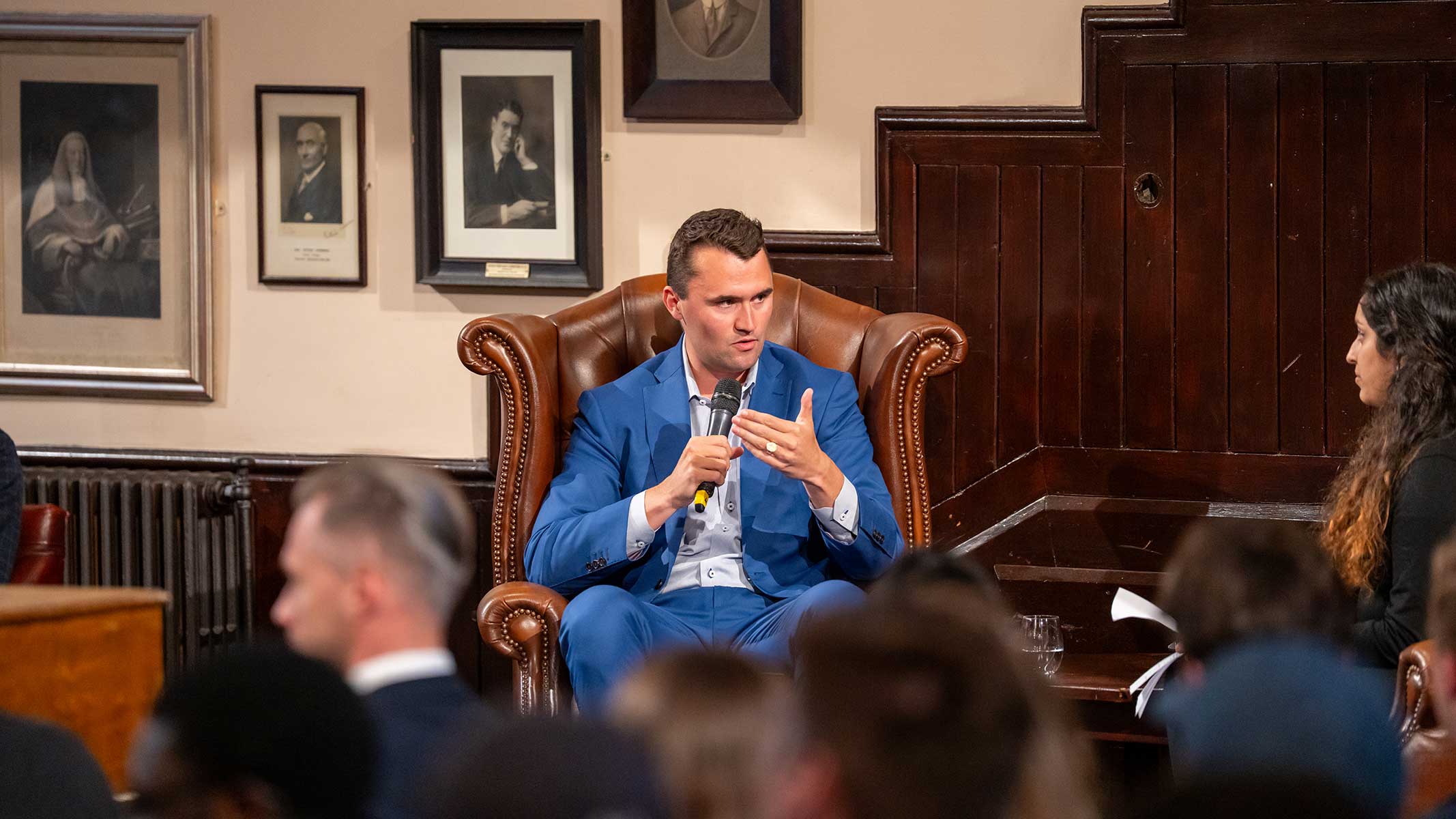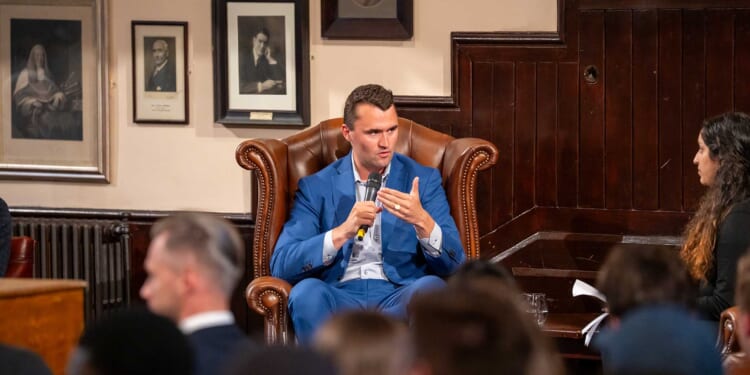
A murder should unite people in shared revulsion. The killing of Charlie Kirk did not. When the 31-year-old founder of Turning Point USA was assassinated last month, leaders in both parties condemned the attack, and many mourned the husband and father of two. But some progressives on social media had a different reaction: they rationalized, mocked, and even celebrated the killing.
The scale of this reaction was not trivial. An online database logged over 63,000 user-submitted posts that cheered Kirk’s death, though the site was later taken down. One of the few unremoved celebratory posts, which references the song “No One Mourns the Wicked,” has 234,000 likes. As Christopher Rufo observed, many who work in the “helping professions”—teachers, nurses, school counselors, social workers, and physicians—celebrated, mocked, or justified the assassination.
Finally, a reason to check your email.
Sign up for our free newsletter today.
This reaction relied on a caricature of Kirk that long predated his death. As Kirk’s profile in the conservative movement grew, progressive media routinely cast him as a dangerous bigot whose rhetoric harmed vulnerable people. In left-wing circles, this depiction hardened into fact. Messages show that Kirk’s alleged killer, 22-year-old Tyler Robinson, absorbed that narrative; he told his trans-identified romantic partner that he could no longer tolerate Kirk’s “hatred.”
But Kirk was not motivated by hatred. Publicly available clips show him rejecting the “white supremacist” label and denouncing white identitarianism, anti-Semitism, and anti-gay bigotry within the conservative movement. He modeled civil disagreement, treating people with respect, showing compassion toward those who identified as transgender, and staying composed even when insulted.
The assassination of a public figure should draw universal condemnation. The fact that Charlie Kirk’s death did not—and that a nontrivial minority even viewed it as comeuppance—indicates a shift in norms, from condemning violence categorically to excusing it when the “right” target is hit.
Three factors contributed to the celebration of Kirk’s assassination: cognitive shortcuts, institutional cues, and a changing conception of what counts as harm.
Americans increasingly live in their own media ecosystems. They patronize their own networks, preferred public figures, and favored news outlets. This is why most Americans say Democrats and Republicans can’t agree on basic facts.
While most citizens lack the time or inclination to study policy or politicians in depth, nearly half of social-media users report engaging in political activism. These platforms’ algorithms inject an often shallow and one-sided stream of news and political content into users’ feeds.
The constant churn of information allows people to consume news simply by opening social media. About a third of adults adopt a “news-finds-me” approach, meaning they wait for important updates to appear in their feeds. Users who consume news this way end up seeking fewer sources, simultaneously knowing less but feeling more informed. Experiments find that sharing even an unread story can inflate people’s sense of how well they understand an issue.
The combination of ignorance and polarization has made political debate on social media increasingly toxic. Hyperpartisan accounts with large followings operate without any real checks on accuracy, freely distorting opponents’ views and presenting them in the worst possible light. Algorithms reward negativity and emotionally charged content. This cycle continues even in the aftermath of a brutal murder.
Immediately after his assassination, a set of false and out-of-context Kirk quotations spread rapidly among progressives on social media. Left-wing accounts used these quotes to argue that Kirk should not be mourned, or that he was even responsible for his own murder. Jess Natale, who runs the popular progressive Instagram account “so.informed,” posted a story calling Kirk “a racist, xenophobic, transphobic, [I]slamophobic, sexist, white nationalist mouthpiece” who “stood for nothing but hate,” adding that she “extend[s] absolutely no empathy for people like that.”
One of the first things people notice about a post is how often others have engaged with it. A large number of likes and shares suggests that many have vetted and endorsed the post’s message; when that number gets sufficiently large, the post feels almost certain to be true. This is called the “bandwagon effect”: believing something because others believe it. As platform algorithms push similar posts, the repetition can cause users to succumb to the “illusory truth effect”: the tendency to believe something is true simply because it is repeated. When the message of these posts aligns with users’ worldview, confirmation bias makes them even less likely to question it or to seek out opposing information.
As political scientist John Zaller observed, most people pay limited attention to politics and rely on trusted sources. Media, political leaders, and organizations—such as the Southern Poverty Law Center and the Anti-Defamation League—therefore play an outsize role in shaping public perceptions.
By the 2010s, watchdog groups like the SPLC and ADL faced a scarcity problem: with fewer open bigots and violent groups in public life, they shifted from tracking the actions of fringe actors to policing the rhetoric of high-visibility conservatives. That expansion kept watchdogs relevant to donors and newsrooms, but it also resulted in more mainstream figures being categorized as “hateful.”
As Kirk’s profile grew, major watchdogs built standing files on him and Turning Point USA. The SPLC published “Turning Point USA: A case study of the hard right in 2024.” It said TPUSA was “emblematic” of the Republican Party’s desire to “enforce a social order rooted in white supremacy.” The ADL’s Center on Extremism posted a later-deleted overview of TPUSA in its Extremism, Terrorism & Bigotry section, accusing the group of attracting racists, its representatives of making bigoted statements, and Kirk of “attack[ing] the transgender community.”
Left-wing activist networks, including watchdog groups, often supply “information subsidies” to newsrooms: prepackaged research, quotes, and narratives intended to shape how a story is told. When mainstream outlets use this material, they give credence to activists’ framing. Many readers regard these outlets as neutral arbiters and miss the bias.
On media bias, Democrats have a major blind spot. Research reveals that many national outlets lean left. AllSides, an independent watchdog, found that outlets like the AP, Bloomberg, USA Today, The Atlantic, Axios, NPR, Politico, ProPublica, and CNBC have moved even further left in recent years. A 2022 Syracuse University survey found that only about 3 percent of U.S. journalists identify as Republicans, compared with about 36 percent who identify as Democrats and about 52 percent who identify as Independents.
Only 45 percent of U.S. journalists say the press should always give equal coverage to all sides, compared with 76 percent of the public. Yet Democrats are less likely than Republicans to say that “most journalists are biased” or that news outlets “favor one side,” and much more likely to report trust in the media.
Charlie Kirk was not bigoted. Yet many people were immersed in an information ecosystem telling them otherwise.
Democrats, like Republicans, use negative partisanship to rally supporters. But today’s Left, including left-leaning news outlets, often suggests that disagreements with their preferred policies are rooted in prejudice. By imputing motives—racism, bigotry, or bias—and attaching pejorative labels, they shift debate from the merits of a proposal to the character of the speaker. That framing primes audiences to assume that conservatives like Kirk are driven by hatred rather than by competing judgments about policy.
According to these narratives, keeping men out of women’s sports or setting age requirements for medical transition, for example, are “transphobic” or “anti-LGBT.” Similarly, criticisms of affirmative action or DEI on fairness or merit grounds are “racist” or “white supremacist.” People readily accept these frames and labels because institutional pressure makes them feel self-evident.
Since the 1960s, three currents in American life have moved together: a structural view of racism, a rise in sensitivity to harm, and expressive individualism. As overt discrimination declined in the wake of the 1964 Civil Rights Act, scholars and activists widened the concept of “racism” to include systems—policies, norms, and outcomes—and proposed equity programs as the remedy.
The structural lens eventually provided grounding for the theory of intersectionality—the view that overlapping identities compound disadvantage and must be analyzed together—which activists applied to sex, sexual orientation, “gender identity,” religion, disability, and immigration status. Over the past decade, these ideas have moved from the realm of academic theory into workplaces, schools, and media, providing the common vocabulary and tool kit of contemporary social justice activism.
As these cultural shifts took hold, a parallel transformation unfolded in counseling and mental health. In response to the increasingly widespread rejection of genuine harms, such as domestic violence, psychology widened its definition of “harm.” Psychologist Nick Haslam calls this “concept creep.” Terms like “emotional abuse,” “trauma,” and “bullying” now include milder or ambiguous experiences. Social media and therapy culture have normalized and amplified this expanded vocabulary.
These trends converged on social media and intensified after the 2020 protests following George Floyd’s death, which mainstreamed the claim that racism is embedded in American systems and often branded rejection of that claim as racist. Slogans such as “silence is violence” and “words are violence” framed nonparticipation and certain speech as inflicting harm. For many young people raised in a culture of expressive individualism—the idea that we define ourselves by what we publicly affirm—having those beliefs challenged constitutes a form of “emotional harm.”
Americans in general, and progressives in particular, are increasingly intolerant of opposing views. Those on the left are more likely than those on the right to say they will not date, befriend, or associate with their political opponents. Young adults who identify as “very liberal” are most likely to believe “violence is often necessary to create social change.” Perhaps unsurprisingly, recent years have seen an uptick in left-wing attacks.
Kirk’s death should have unified the country, but it didn’t. That’s because too many had been taught to see him—and those like him—not as participants in a democratic argument but as an embodiment of hate.
What Kirk was doing when he was assassinated—debating college students, exposing them to other points of view, showing that disagreement can be handled without contempt, and modeling civil discourse—was precisely the remedy our culture needs. Asked why he went to campuses, Kirk said, “When people stop talking, that’s when you get violence.” His warning was prophetic.
Young people should strive after the kind of civil discourse Kirk modeled on campus. That entails moving beyond surface-level politics and learning enough to defend their views; recognizing that their minds can change; cultivating an awareness of bias; seeking out the strongest opposing arguments; and refusing to let policy dispute slide into personal vilification. Above all, they should reject political violence.
None of this demands agreement with Kirk’s positions. It requires only a minimum civic standard: treat your opponents as fellow citizens, conduct arguments on the terrain of reasons and evidence, and keep the conversation open.
Photo by Nordin Catic/Getty Images for The Cambridge Union
Source link

















